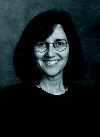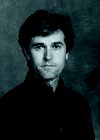
Venter hoped to demonstrate that a technique called whole-genome shotgun sequencing, previously successful with microbes, could work for the much larger and more complex genomes of higher organisms—an essential step in his plan to apply the technique to the human genome.
The fly was an ideal testbed: D. melanogaster�s genome, with 120 million bases, is intermediate in size between microbes and humans—and when finished, the accuracy of the whole-genome shotgun sequence could be checked against the existing data, including 28 million bases of finished sequence and completed physical maps. Most of this work had been done by the Drosophila Genome Sequencing Laboratory in Berkeley Lab�s Life Sciences Division, where Susan Celniker is codirector with Rubin.
Whole-genome shotgun sequencing involves determining
the sequence of millions of small cloned pieces of DNA that represent all
of an organism�s genome in multiple overlapping stretches. In the case of
Drosophila the project involved over 3 million stretches of sequence—a
twelve-fold oversampling of the genome—that had to be correctly assembled.
![]()

![]()
SUSAN
CELNIKER
ROGER
HOSKINS

In
1983 Susan Celniker got her Ph.D. in biochemistry from
the University of North Carolina and simultaneously wrote
a chemistry dissertation at Caltech, where as a research
fellow her studies of Drosophila began. Celniker maintains
her ties with Caltech, but joined Berkeley Lab in 1996
to codirect the sequencing program with the BDGP�s Gerald
Rubin.
Roger Hoskins applied the tools of molecular genetics
to "model" organisms while an undergraduate at Rice and
continued his work at the Laboratory of Molecular Biology
in Cambridge, England, earning his doctorate in 1990.
After postdoctoral work at Stanford he joined Berkeley
Lab in 1996; following a brief digression into human genomics,
Drosophila won his allegiance.
"No one knew whether whole-genome shotgun sequencing would work for the fly genome," says Berkeley Lab�s Roger Hoskins, leader of the BDGP physical mapping project, "but we knew that if it did, it would be faster and more efficient than traditional methods."
An integral part of the effort was genome physical maps, ordered sets of large cloned pieces of DNA that overlap each other and span the chromosomes. The fruit fly has five chromosomes (humans have 24); Hoskins and his colleagues concentrated on constructing a detailed physical map of the large chromosomes 2 and 3, which account for over 80 percent of the fly�s genome.
Starting with a random collection of clones, the challenge is to determine their relative order and the extent of their overlap. In the method applied at Berkeley Lab, clones are distinguished by the particular "sequence tag sites" (STSs) they contain. Sets of clones that share one or more of these unique short DNA sequences must overlap; with enough STSs, the clones can be lined up along the entire length of the chromosomes.
Working with 2,000 STSs and 18,000 clones (known as "bacterial artificial chromosomes," BACs, because they are replicated in E. coli bacteria), the Berkeley Lab group was able to use a computer program called SEGMAP to determine the order of the BAC clones based on the STSs they shared.
The more clones that overlap along the chromosome, the greater the confidence in the accuracy of map assembly and genome sequencing. The Berkeley Lab map reaches an average depth of some 13 overlapping BAC clones and is the most accurate and complete STS content map ever constructed for any genome.
The researchers checked and integrated their BAC-based STS content map with other techniques, including a "restriction fingerprint map" made by BDGP affiliates at Baylor College of Medicine in Houston. They also confirmed their map by hybridizing BAC clones directly to the chromosomes themselves—allowing the clones to match up with their corresponding sequences on the chromosomes.
This is possible because "the chromosomes of the larval salivary glands of Drosophila are unusual, in that the DNA replicates many times to form multiple copies in perfect register," says Susan Celniker. "This helps the larva make lots of a particular protein in a short time."
And because these so-called polytene chromosomes have stereotypic banding patterns that unambiguously identify regions of the chromosomes, says Celniker, "it also helps researchers map the locations of genes and other DNA sequences on the chromosomes."
Working with colleagues in Gerald Rubin�s laboratory on the UC Berkeley campus, the Berkeley Lab researchers demonstrated 98 percent coverage of the polytene by clones in their map.
When the map was complete—along with maps of the much shorter chromosomes 4 and X produced by other institutions—the Berkeley Lab and Baylor researchers made a "rough draft" sequence of the genome, which served as a check against Celera�s whole-genome shotgun sequence. The rough draft is being used to close the hundreds of remaining gaps in the Celera sequence and to improve its accuracy.
The completion of D. melanogaster�s genome and the enumeration of its 13,601 genes were announced in a special issue of Science magazine on March 24, 2000. Far more than just a model for the whole-genome shotgun-sequencing approach, the achievement has profound implications for basic research in biology and human disease.
"The underlying biochemistry of fruit flies and humans is remarkably similar," says Roger Hoskins. "Fruit flies can provide clues to understanding human genetic diseases."
"We can identify and study human disease genes in flies more easily than we can in other model organisms such as the mouse," says Susan Celniker, pointing out that experiments can be done using fly genes that would be impractical (or unthinkable) using human subjects.
Along with Celniker and Hoskins, other members of the BDGP group�s management team at Berkeley Lab are Reed George, Suzanna Lewis, Mark Stapleton, and Richard Galle. After 90 years of pioneering discoveries, the swift completion of the fruit fly genome stands as the latest milestone in genetic research made possible by this remarkable animal. — Paul Preuss
|
Next > | |||